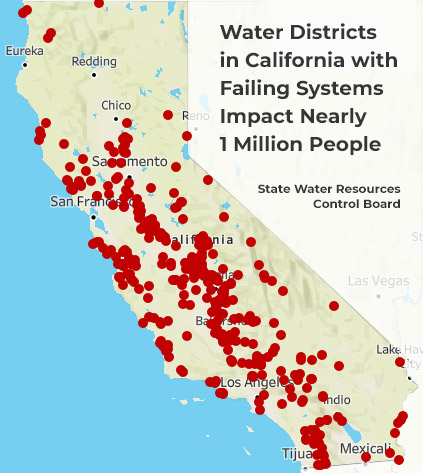 The number of failed water systems in California has jumped about 25% since 2021. In fact, hundreds of water systems in the state have failed for years to provide safe drinking water. According to experts, officials and community activists, the proliferation of failing water systems in California is due to multiple factors that include:
The number of failed water systems in California has jumped about 25% since 2021. In fact, hundreds of water systems in the state have failed for years to provide safe drinking water. According to experts, officials and community activists, the proliferation of failing water systems in California is due to multiple factors that include:
- Aging infrastructure
- Inadequate financial investment, lack of managerial and technical capacity within systems
- Aquifer over pumping
- Discriminatory policies and chronic disinvestment in affected communities
Examples of contaminates found in tap water delivered by failed water systems:
- Lead and Other Heavy Metals: Aging infrastructure containing lead pipes or fittings can leach lead into the water supply, especially when water chemistry changes due to system failures.
- Microorganisms: Bacteria, viruses, and parasites may contaminate water during system failures, leading to health risks such as gastrointestinal illnesses.
- Chemical Contaminants: These can come from industrial spills, agricultural runoff, or malfunctioning water treatment processes. Chemicals such as pesticides, fertilizers, heavy metals, and volatile organic compounds (VOCs) may be present.
How do regulations help keep our drinking water safe to drink?
Federal, state and local governments all have a hand in protecting public water systems and private wells from contamination. Regulations play a crucial role in ensuring the safety of drinking water by:
- Setting Standards
- Monitoring and Testing
- Treatment Requirements
- Reporting and Transparency
- Enforcement
Overall, regulations provide a framework for safeguarding the quality of drinking water and protecting public health by ensuring that water supplies meet established safety standards and are properly monitored, treated, and managed.
How WaterWorkforce helps municipalities stay in compliance with Federal, state and local government regulations
We specialize in helping clients facing regulatory violations and fines get back into compliance. Our specialists work with clients and regulators to determine areas of non-compliance, remedy violations, and establish master sampling and reporting schedules. Examples include MCL exceedances, sampling violations, failure to submit reports, and failure to maintain infrastructure.
Learn more about our expert consulting services.
Questions?
Contact:
Bret Kadel, CEO
WaterWorkforce Inc.
Email: bretk@waterworkforce.com
